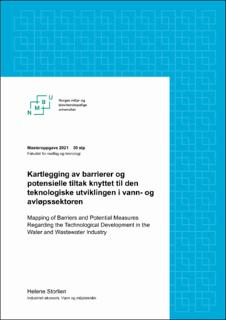| dc.contributor.advisor | Stevik, Tor Kristian | |
| dc.contributor.advisor | Ratnaweera, Harsha | |
| dc.contributor.author | Storlien, Helene | |
| dc.date.accessioned | 2021-10-11T07:07:05Z | |
| dc.date.available | 2021-10-11T07:07:05Z | |
| dc.date.issued | 2021 | |
| dc.identifier.uri | https://hdl.handle.net/11250/2788904 | |
| dc.description.abstract | Norsk vann- og avløpssektor står overfor store utfordringer når det kommer til utvikling i tiden framover. Klima endrer seg, og det kommer stadig strengere krav fra myndighetene. Dette innebærer et behov for økt investering, teknologiutvikling og innovasjon. Kommunene ønsker så lave avgifter til abonnentene som mulig, og investeringene må derfor gjøres på en kostnadseffektiv og bærekraftig måte.
Selv om behovet for utvikling er stort, har man sett at det kan være vanskelig å komme inn på markedet med ny teknologi. Det finnes store forbedringspotensialer og muligheter når det kommer til utvikling i sektoren. Formålet med denne oppgaven er derfor å kartlegge dagens situasjon og bidra til mer bevissthet innad i sektoren. Oppgaven studerer hvilke barrierer som finnes og mulig tiltak knyttet til den teknologiske utviklingen i vann- og avløpssektoren.
Oppgaven benytter seg av to forskningsspørsmål for å studere problemstillingen nærmere:
● Hvilke barrierer bremser muligheten for ny teknologi i vann- og avløpssektoren?
● Hvilke tiltak burde innføres for å sikre kontinuerlig utvikling og implementering av ny teknologi i vann- og avløpssektoren?
Gjennom dybdeintervjuer med 12 personer innenfor sektoren ble det opparbeidet data og kartlagt ulike barrierer og tiltak. Informasjon innhentet gjennom intervju og litteraturstudie danner grunnlaget for videre diskusjon i oppgaven.
Resultatene tilsier at den generelle oppfatningen av situasjonen er lik hos de fleste i bransjen. Studien har vist at det finnes flere åpenbare barrierer. Manglende kompetanse, holdning, risiko og regelverk er eksempler på noen av barrierene bransjen står ovenfor. I tillegg kom det fram flere mulige tiltak for å sikre utvikling. Dette kan være bedre samarbeid innad i bransjen, kompetanseutvikling og tilskuddsordninger. Kjernen i problemet og årsaken til at man ikke opplever større grad av utvikling er mangel på insentiver for å drive innovasjon i bransjen. For å imøtekomme fremtidens utfordringer er det helt elementært at man som bransje tar dette på alvor og iverksetter tiltak. | en_US |
| dc.description.abstract | The Norwegian water and wastewater industry is facing great challenges in relation to future development. The climate is changing, and the government is constantly escalating their strict demands. As a result, there is a need for increased investment, technological development and innovation. The municipalities wants the costs for their users to be as low as possible, which means that the investments need to be both cost-effective and sustainable.
Even though there is a considerable need for development, reality has shown that it might be difficult to enter the market with new technology. There is great potential for improvement and possibilities regarding development in the industry. The purpose of this thesis is therefore to map the current situation and to contribute to more awareness within the industry. The thesis investigates which barriers exist and possible measures regarding the technological development in the water and wastewater industry.
The thesis is based on two research questions in order to investigate the research aim closer:
● Which barriers limits the possibility of new technology in the waste and wastewater industry?
● Which measures should be taken in order to assure continuous development and the implementation of new technology in the waste and wastewater industry?
The data was collected through in-depth interviews with 12 employees in the industry, which made it possible to map the various barriers and measures. The data which was collected through the interviews, as well as the theoretical framework, provide the foundation for further discussion in the thesis.
The results suggest that there is a shared understanding of the current situation among the people in the industry. Furthermore, the study shows that there are multiple clear barriers. Lack of competence, attitude, risks and regulations are examples of some of the challenges that the industry is facing. In addition, there are several potential measures to secure the development that emerge from the results. This might be better co-operation within the industry, competence development and subsidy schemes. The root of the problem, as well as the cause of limited development, is lack of incentives to drive innovation in the industry. In order to accommodate
the challenges of the future, it is elementary that the industry acknowledges the issue and takes measures. | en_US |
| dc.language.iso | nob | en_US |
| dc.publisher | Norwegian University of Life Sciences, Ås | en_US |
| dc.rights | Attribution-NonCommercial-NoDerivatives 4.0 Internasjonal | * |
| dc.rights.uri | http://creativecommons.org/licenses/by-nc-nd/4.0/deed.no | * |
| dc.title | Kartlegging av barrierer og potensielle tiltak knyttet til den teknologiske utviklingen i vann- og avløpssektoren | en_US |
| dc.title.alternative | Mapping of barriers and potential measures regarding the technological development in the water and wastewater industry | en_US |
| dc.type | Master thesis | en_US |
| dc.description.localcode | M-IØ | en_US |

